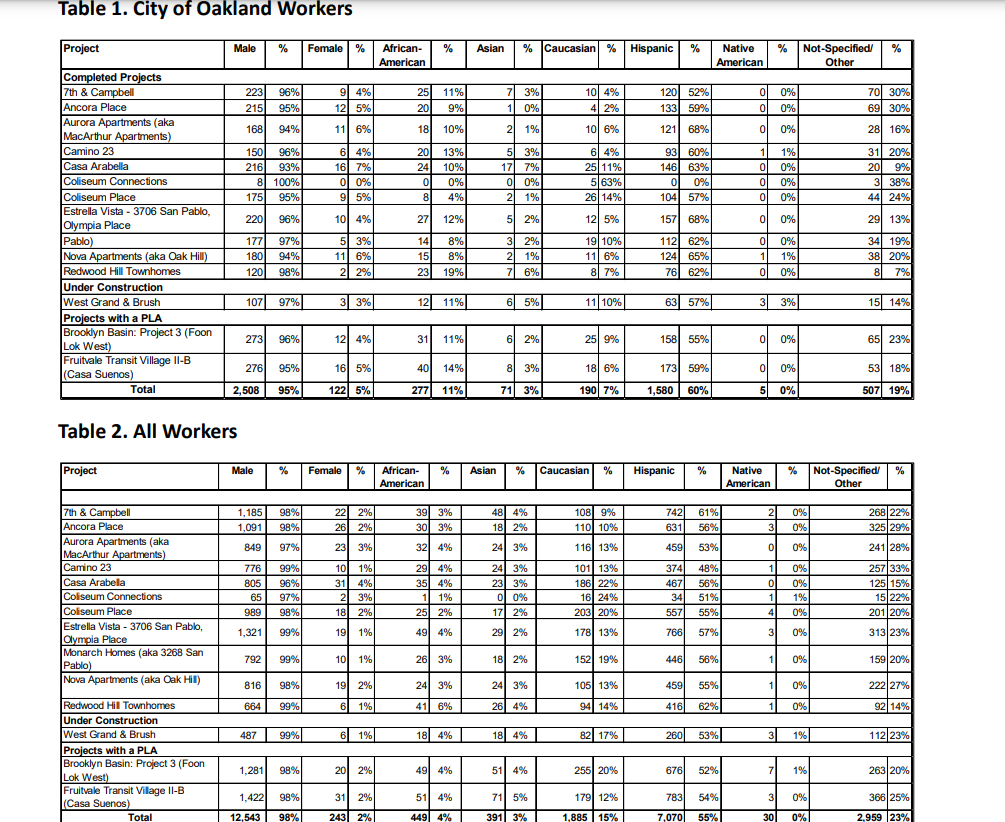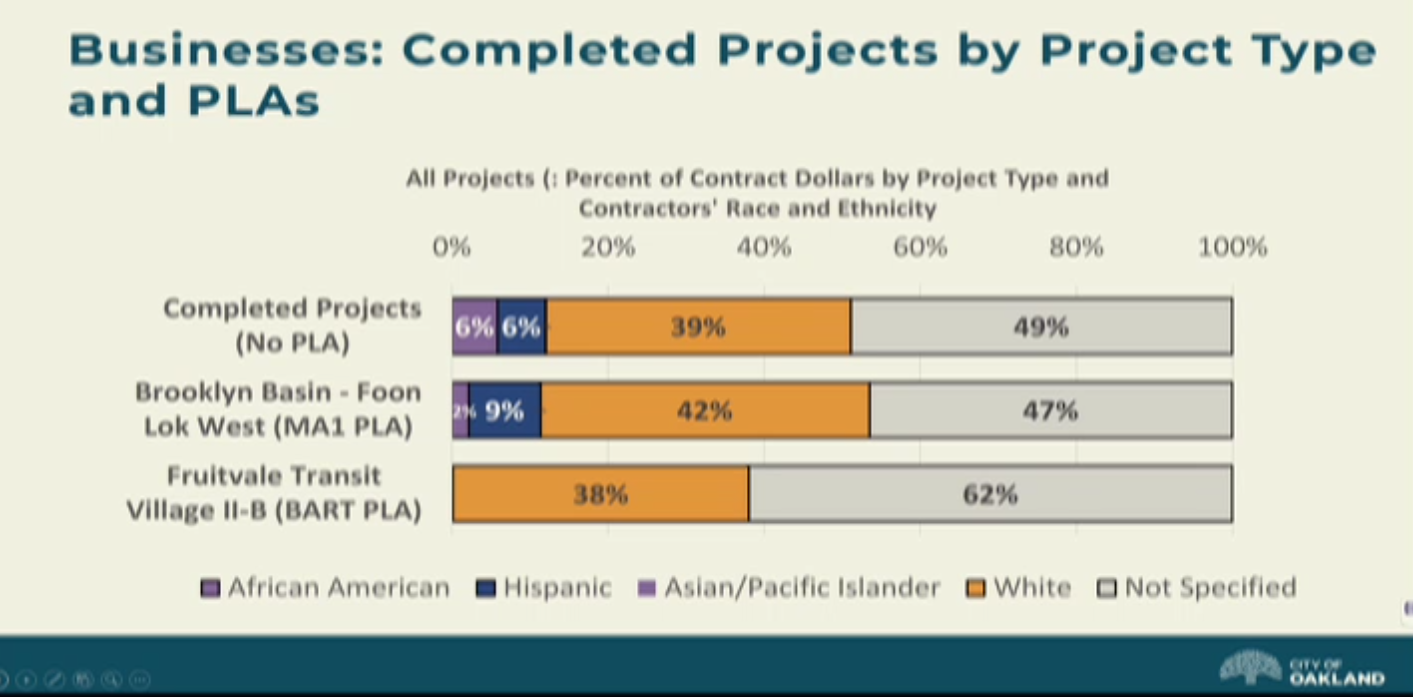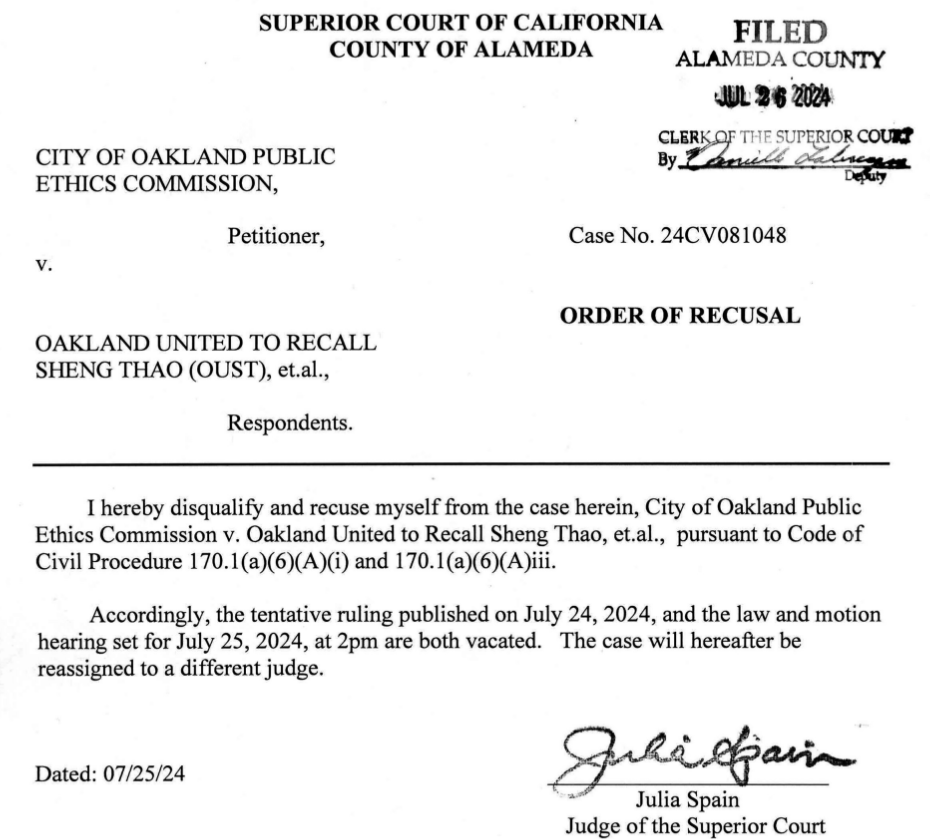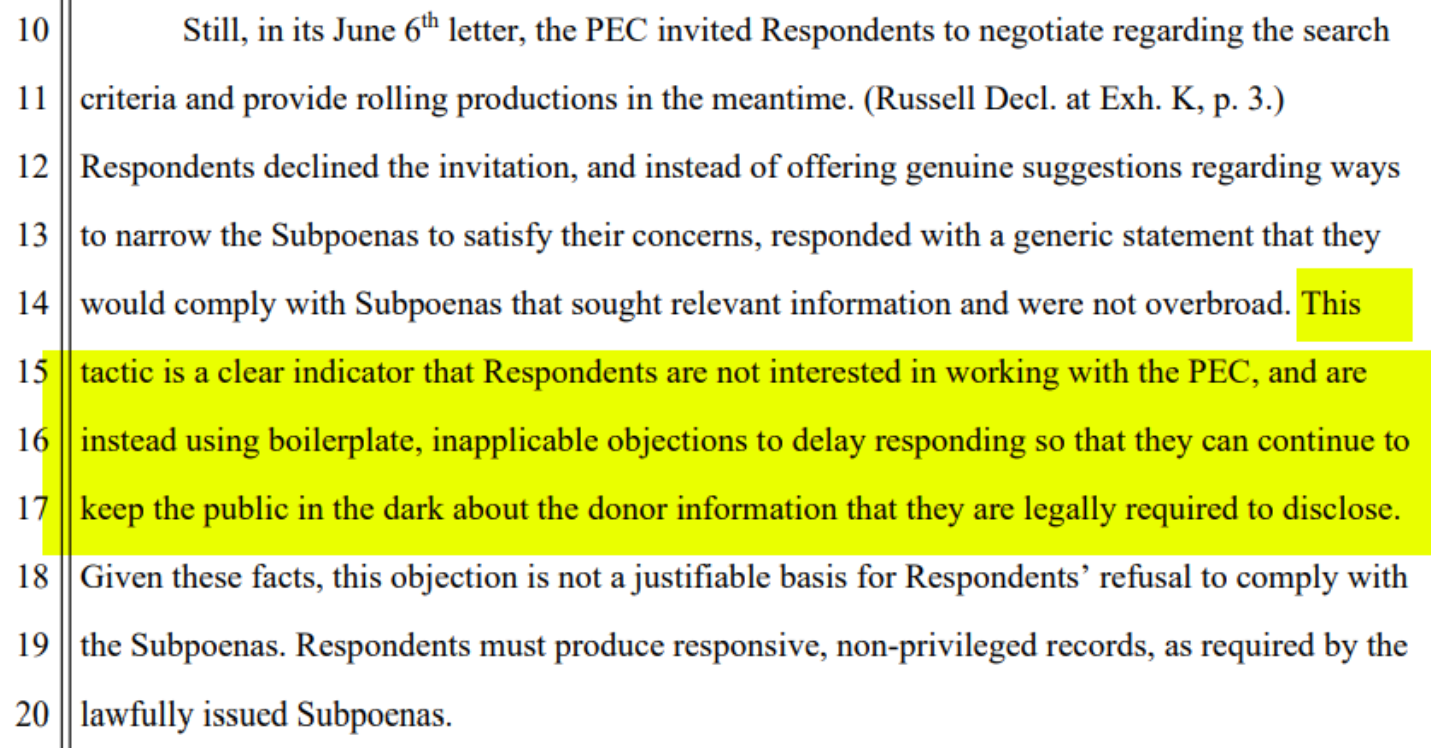In Confused Vote, Committee Forwards PLA Question for Measure U Funding to Council
A controversial plan to add a Project Labor Agreement [PLA] that would compel affordable housing developers into expansive union contracts in Measure U-funded projects passed a significant hurdle Tuesday. The four council members in the Community and Economic Development [CED] committee, which has been reviewing the idea since February, voted unanimously to send a recommendation to the full Council to consider requiring a PLA for all Measure U-funded projects over a certain unit limit. The PLA, according to its proponents at the The Building and Construction Trades Council of Alameda County [aka Building Trades], would parallel the one attached to county housing bond Measure A-1 [MA1].
Council members, including the initiator of the motion, CM Kevin Jenkins, appeared confused about what they were supporting in the vote, however, or how it would work. At one point in the deliberation, Jenkins, who has been pushing the idea on behalf of the Building Trades for months, seemed to think the legislation would compel the City Administrator’s office to create the PLA, with developers then required to sign on to it. Staff reminded him that negotiating a PLA with the developers goes beyond the role of city staff and the City Council's only decision in September is whether to require a PLA of developers applying for Measure U dollars.
The item will come before Council as a Notice of Funds Availability is published. Voting to require a PLA at the September meeting would mean that affordable housing developers would then have to negotiate with the Building Trades over a PLA before receiving Measure U funding—a process that for MA1 took 18 months.
The Housing and Community Development Department [HCD] has warned in previous discussions that any requirement of a PLA to qualify for Measure U funding will slow down affordable housing projects, which would have repercussions in leveraging City dollars for state and federal level funding.
Low Participation of Black Workforce in Trades and Construction
An issue central to the deliberations is the copious failure to include Oakland’s Black workforce in the region’s building boom of the past decade. Oakland’s Black worker construction participation has been low by all metrics—but its middling level in the Trades, ostensibly the politically backed vehicle for worker equity—has been a sticking point in Oakland for years. A proposed public lands policy that would have set up strict rules under which public land could be sold foundered on required negotiations with the Building Trades several years ago. The Building Trades balked when asked for demographic data on their workforce inclusion of Oakland’s Black workforce.
Another attempt in 2021 and 2022 by the Trades to get a city-wide PLA again failed to get the Trades to be transparent with demographic information, triggering significant doubts about the umbrella organization’s commitment to deep diversity in hiring practices. Without local Building Trades demographic data, the City in the 2021-22 process relied on national level data and a report by Estolano Associates that found low participation in construction and in the Building Trades by the Black workforce nationally.
Few, but Illustrative, Lessons Available from the Oakland MA1 PLA Projects
As a response and recommended course of action to the Building Trades initiated quest for a Measure U PLA, City Staff framed the decision as a choice of three options.
1) Apply current labor standards and fully implement and enforce the laws.
2) Expand current labor standards with an Ordinance based on regional labor standards modeled on AB 2011
3) Adopt a Resolution that requires developers to negotiate a Project Labor Agreement (PLA) with specified labor standards terms.
In preparation for the decision, City Staff in the Department of Workforce Employment Standards [DWES] provided analysis of the available data, which mostly comes from the PLA and non-PLA developments funded by MA1. Staff acknowledged the data is insufficient to properly gauge outcomes. Only one MA1 project in Oakland had a PLA, at Brooklyn Basin–and only two of the 28 MA1 completed projects have one in the entire county. The MA1 PLA agreement also has an 80 unit threshold—and almost all affordable developers seeking MA1 funding appear to have deliberately designed their projects with fewer units to get the funding. Some may have foregone the MA1 funding to avoid the PLA threshold.
Brooklyn Basin's Outcomes
The outcome in the small data set for the MA1 PLA relegated to Brooklyn Basin has mixed but uninspiring outcomes. When looked at as a proportion of Oakland residing workers, the Brooklyn Basin project had higher Black Oakland resident participation than the average. But the number is dwarfed when compared to the share of the workers on site from greater Alameda County. Workers from Alameda County represent around 5 times Oakland’s workforce on the Brooklyn Basin project. As a percentage of the entire workforce on the job, Oakland’s Black population represented only 4% of the workforce, lower than its share in the County's construction workforce. Oakland workers were responsible for less than half the work hours on the Brooklyn Basin project.

In both the Oakland and regional context, Latino workers have a much higher share of the site work at Brooklyn Basin and the white ALCO workforce is also about 5 times that of the Black workforce on the site. The issue is compounded by the fact that Black owned contractors—Trades deficits in Black hiring could be made up by Black contractors more likely to hire Black workers—are a miniscule share of the sub-contractor landscape on both the non-PLA MA1 projects and PLA work. White contractors, and those that did not specify ethnicity, which are likely white, had the lion’s share of work for both.

Race/Equity Department Doubtful about PLA, Apprenticeship Programs
In her commentary on the project, the City’s Race and Equity Director Darlene Flynn repeated the same concerns about the potential Measure U PLA she’s highlighted since the deliberations began earlier in the year. Flynn has been critical of the idea since it was first introduced.
Flynn noted MA1's record with PLAs, and especially in affordable housing, would take years to yield reliable data given the few projects that have come through the pipeline—while the Building Trades apparently decline to be transparent with their own data about Black employment. Flynn, lauded the outcomes of Rising Sun and Cypress Mandela, two city funded training centers that are the Oakland’s Black workforce's best hope of feeding into the Building Trades as apprentices. But Flynn repeated her concerns about the static representation of Black workers in the Building Trades.
“Rising Sun and Cypress Mandela have never been the problem. It is structures that they are feeding into that make it difficult and present barriers for these new apprentices to become permanently employed journey-level workers that will cause their lives to change. And we can always find exceptional examples of people who have made it through and who have gotten there. But what we need is data that tells us whether or not we're getting there in general, and the national data tells us that Black workers in building trades unions have not made progress in the last decade, in spite of plenty of lip service to change and wanting to do the equitable thing,” Flynn told Council members.
Flynn noted that the culture of the Building Trades itself may have more to do with Black workers achieving Journey- status, and thus permanent and reliable work.
“Each of the trade unions has their own way of bringing people in as permanent trade members. Sometimes it's one on one interviews and whether or not you belong here and fit. That's okay. Trade unions can do it the way they want to do it, but I'm here to do my job and say we've made a commitment to not endorse things that are not going to produce equitable change for Black residents in the city of Oakland…Black residents are the ones who are suffering from the highest impacts of unemployment, the highest impacts of homelessness," Flynn said.
While several representatives of the City’s apprentice feeder programs attested that BIPOC and women participation in the programs’ is high and supported the PLA, they also noted that it was not enough to counteract the current demographic composition of the Trades and construction in general in the Bay Area. Anita Douglas, who is on the board of Cypress Mandela and came to the meeting to support the PLA for Measure U, also acknowledged that institutional racism remains a difficult hurdle for Black construction workers—and especially Black women construction workers—to overcome.
“The problems are not in the training programs. The problems are in the requirements on the contractors, who are the ones who hire the apprentices. I also agree…that we don't have enough data. So for Black workers, it is extremely difficult on a cultural level, on other levels, for them to get into the apprenticeships. There is still racism, not just in the Trades, but in the contractors who do the hiring. So there are a lot of challenges, but I do feel like Rising Sun, Cypress and the other programs are doing everything we can to support those who are in the Trades, who are in the programs and trying to get into apprenticeship programs and journey out,” Douglas said
Higher Costs per Unit Likely Under PLA
Of equal concern to Flynn in previous meetings is that a PLA could, on top of denying access to good employment, harm Black residents access to affordable housing. Black residents have the highest share of rent burden and homelessness, a reality echoed by affordable housing developers attending, including Carolyn Johnson, the CEO of the Black Cultural Zone. Johnson's Black Cultural Zone is currently building around 119 units of affordable housing at a residential project on City-owned land at East Oakland’s Eastmont Center.
“We compete at the state level, and it's a very precarious pathway to get these deals funded—increased complexity means there are fewer potential housing units. So 1 to 3% increase in cost is about seven and a half million dollars in project costs…every unit that we don't build there’s a tent that stays up,” Johnson said.
Johnson, like all of the affordable housing developers and advocates who've spoken at the meetings and have been surveyed in the reports, recommend that Council choose a combination of options 1 and 2. The requirements of an agreement based on AB 2011 would require developers to pay the prevailing wage, health benefits, be signatory to a collective bargaining agreement and accept apprentices. The combination would not change much of the City’s current status quo or labor-regulations for city-funded projects except in maximizing enforcement. Johnson, Flynn and others noted that almost all affordable housing developments already have an 85% unionized workforce, the City already requires prevailing wage on its city-funded projects.
The Building Trades and their non-profit advocacy organization, The Construction Trades Workforce Initiative [CTWI] argue that PLA projects are actually cheaper to build than non-PLA projects, but no research presented to Council demonstrates this. A RAND corporation study included in the legislative report shows that an increase of 15% per unit could result from the added costs of a PLA. While a UC Berkeley study showed no increased costs, RAND and, separately, City staff, claim there are data errors in the calculations that when accounted for, show an equal or greater cost as the Rand study.
Other developers note that the cost of projects currently under construction would increase from 1 to 3% if they were compelled to have near-100% union hire through a PLA.
“The 2 to 3% premium that we were citing from Mercy Housing was information from our general contractor. They're a union signatory contractor, so they already had a very high union participation. We participate 85 to 90% [union] without a PLA and so that that premium is really the premium of getting from that 85-90% to the PLA amount,” Tim Dunn of Mercy Housing told Council members.
The wide-range of potentially increased costs proved to be another sticking point for CMs who said they wanted reliable data with which to base a decision. A 15% increase could bring $150k per unit costs to $250K, and reduce the number of units by 40%. A city staffer told Council members that at a 15% increase in costs, there could be as much as a 770-unit reduction in the number of units produced with Measure U dollars. At the low end with 1-3% cost increases, the loss of units would be around 230.
At a certain point, Building Trades Secretary/Treasurer, Andreas Cluver, who has spearheaded the initiative at Council, seemed to concede that there would be an increase in costs to developers.
"I think in terms of the cost, yes, if we have a 2% increase, I think that is a small price to pay to make sure that workers have a voice on the job, that they are not being exploited. And we have numerous letters about prevailing wage violations," Cluver said. Cluver did not address the consequent lower production of affordable housing that city staff and developers say would be a consequence of the increased costs.
Jenkins May Have Intended for City Staff to Craft PLA
During deliberation CMs agreed to forward a recommendation for the Building Trades PLA to full Council in September, based on Jenkins’ motion. But the fact that the motion appeared to direct the City staff to create a PLA for consideration, something staff cannot do, created much confusion and word-smithing on the dais.
As the deliberation wore on, with increasing uncertainty about the ramifications of Jenkins' proposal, City Administrator Jestin Johnson clarified the role of staff.
“The process with option three is one that we don't control. I think our chief housing policy officer was very clear as to what that process is. It's not a staff driven process. It’s a negotiation between the Building Trades and the respective entities that they will be negotiating with. Now, if it means, you know, convening of stakeholders and trying to get people around the table, sure, that's something we can consider, but the process has been made very clear,” Johnson noted.
Assistant City Administrator Betsy Lake also noted that the process that created the MA1 PLA took 18 months, and though using the MA1 PLA as a platform might speed things up, it would still be a lengthy undertaking.
East Bay Housing Organization's Jeff Levin and other affordable housing advocates have argued that even using a boilerplate of MA1, an Oakland specific process could also take a significant, unknowable, amount of time which would delay the NOFA process.
"Given past experience, 18 months to negotiate the original A1 PLA...it's unlikely that we could conclude this work in a month in order to get the NOFA out. So we encourage you to support a combination of options, one and two to best support our local workers and contractors keep Oakland competitive for state funding and maximize the number of affordable units we can build," Levin said.
CM Carroll Fife noted that she didn’t see a clear consensus towards the PLA among the stakeholders, and noted that organizations like NAMAC, which represents Black contractors in Northern California had not been heard from at the meeting.
“I took notes on every public speaker, and we have consensus on the options that we were asked to choose from today, and it does not land us at option three. That doesn't mean that I don't believe that we should have project labor agreements–I do. But we have to do it with consensus from every group,” Fife said. Regardless, she also voted to forward the report to Council with the recommendation, along with more information and data. CM Dan Kalb agreed that the issue requires the input of the full council.
The struggle to understand what the committee was forwarding as the result of Jenkins’ motion, however, lasted around a half hour, with staff reminding the Council members several times that the City could not draft a PLA nor be involved in negotiations before the vote. A requirement to have a negotiated PLA before receiving Measure U dollars would, regardless, delay this year’s funding tranche, according to city staff. Council could vote for a recommendation to require the PLA in September's vote, or choose another option.

PEC Suit Against Thao Recall Proponents in Limbo as Judge Recuses, Vacates Tentative Ruling Denying Subpoenas Ahead of Friday Hearing
In an unexpected move Friday morning, Alameda County Superior Court Judge Julia Spain recused herself from a suit to compel the proponents and financiers of the recall of Mayor Sheng Thao to produce documents for subpoenas. The Public Ethics Commission [PEC] brought the suit after the recall proponents, among them former Judge Brenda Harbin Forte, and principals in an allied organization Foundational Oakland Unites [FOU], refused to comply with the PEC’s investigative subpoenas for communications between the network of financiers and proponents.
The PEC alleges in court documents that the organizations are trying to hide the source of recall funds from the public. FOU donated over $200K in in-kind funds to pay for signature gathering for the group, but its source of funding remains unreported at this time.

On Wednesday, July 24, Spain published a tentative ruling denying mandatory compliance with PEC’s subpoenas—in her ruling, Spain argued that the subpoenas were overbroad and even unconstitutional. A tentative ruling is not the final ruling in a case, and is usually provided so that parties have the option to contest it at a final hearing—the parties are allowed to contest the ruling, and though very rare, a judge can change some or all of their ruling.
Per the rules of the court, the PEC had until 4pm the next day, Thursday, July 25, to notify Spain that the agency intended to contest the ruling. A source with direct knowledge confirms that the PEC had emailed confirmation of the intention to contest Spain’s ruling orally at the hearing. The PEC intended to pose specific questions around constitutional issues Spain highlighted in her ruling and request the option of amending the subpoenas.
But the PEC never had the chance to argue its position. At 10:56 am, according to a time stamp on the document, about three hours before the scheduled hearing, Spain submitted her recusal. At some point between issuing her ruling Wednesday and submitting her recusal Friday morning, Spain had decided she could not continue with the case. The recusal automatically withdraws her order and ruling and its been removed from the document list on the court website, though this publication had already obtained a copy previously.
There are still no answers about the reason for the recusal. The PEC, through its Director Nicolas Heidorn, confirmed to this publication that the agency did not seek Spain’s recusal and that the PEC is not aware of any specific reason for it. In light of the recusal, the original management conference date scheduled to hear the case of November 6, 2024, is now the only future hearing date listed for the case at the Superior Court’s website.
In her recusal, Spain cites the following rationale from Codes of Civil Procedure: 170.1(a)(6)(A)(i) and 170.1(a)(6)(A) (iii):
(i) The judge believes his or her recusal would further the interests of justice.
(iii) A person aware of the facts might reasonably entertain a doubt that the judge would be able to be impartial.
On Monday, Judge Rebekah Evenson was appointed to the case, according to the Court site. Evenson has served on the court since 2020. Evenson is a Yale Law graduate, the former director of litigation and advocacy at Bay Area Legal Aid, and was a senior staff attorney at Prison Law Office for nearly a decade.
Here is the PEC’s original motion:

$6 MM Police Records Management System to Replace Archaic OPD System
Authorization for a new police records management system [RMS] is on its way to Council tomorrow with a $6MM price tag over five years. The new system comes after a frustrated attempt to upgrade the City's Motorola CAD system and its RMS beginning in 2017. At that time, the OPD sought a Motorola upgraded system for both, as, according to Tony Batala, Director of Information Technology, the department that has stewarded the new process, the system was too antiquated to continue.
But the RMS upgrade to the Motorola system originally sought by OPD also did not function well—Batala told Council members that it increased reporting times by 50 to 60%, mostly because it was not compatible with the National Incident Based Reporting System [NIBRS] used by state and federal agencies. OPD tried to pivot away from the system, but Covid and Ransomware got in the way, Batala said.
By the end of 2023, OPD and IT began testing a new system, Mark43, which is cloud based but can be integrated with the new Motorola CAD system, which is due to be implemented in the coming weeks, according to Batala. The OPD’s technology specialist, Dr. Carlo Beckman, told CMs that the ALCO Sheriff’s Department currently uses the system and is very satisfied with it.
“We visited the Alameda County Sheriff's Office. So they utilized this system, and in fact, they were very smitten with it, and showed us all the bells and whistles. And that's where we got ideas of what we would like to see in our version,” Beckman said.
Mark43 will cost about $600K more per year than the existing system, according to Batala—the increase will be to IT’s budget, however, not the OPD. The system, according to staff, has an easier to use interface, and other features, like real time traffic collision tracking. The system has been tested by dozens of officers, according to Beckman. But it may still be years before the system is completely integrated into the new CAD system set to go live in the coming weeks—Beckman told Council members the system may not be fully implemented before 2026, however.
The item was forwarded enthusiastically by Council members Janani Ramachandran, Carroll Fife, Rebecca Kaplan and Treva Reid to full Council, where it will be heard tomorrow. The Privacy Advisory Commission Chair, Brian Hofer, who happened to be at the meeting presenting the PAC’s annual report, lauded OPD and IT’s implementation of the software. Hofer told Council members that often the PAC’s requests have not been physically possible due to OPD’s deteriorating record system and expected the Mark43 software would add greater transparency and accountability to OPD’s record keeping.
“The things you guys know I value, transparency, the report writing, the accountability…I hope this gets a unanimous vote. I will help them unpack it and install it,” Hofer said.

City Agrees on Term Sheet for Its Share of Coliseum with AASEG, Sale to be Executed Late August
The City of Oakland announced today that it had reached an agreement on a Term Sheet with the African American Sports and Entertainment Group. The Term Sheet seems an exact match to the deal that Thao announced several months ago: 25% affordable housing and negotiated Community Benefits Agreement by deed restriction, at a sale price of $105 MM.
A copy of the Term Sheet viewed by this publication stipulates that the sale will be executed by August 23, 2024. At time of execution, according to the term sheet, AASEG will make a down payment of $5MM, then another payment of $10 MM by September 1, and another $15 MM by November 1. In mid-January, AASEG would pay another $33 MM completing the first tranche of payment expected this fiscal year. The remaining $42 MM would be due at closing, which cannot happen legally until the City completes its final payments on its bond in mid-2026.
The sale with $63 MM paid this fiscal year would obviate any contingencies that the City would have had to carry out if the deal had fallen through. The Term Sheet is not a sale agreement, however, and the agreement must still be carried out.
During the meeting authorizing the City Administrator's office to negotiate the sale, the City Administrator's office and City Council members committed to bringing the Development Agreement back before Council for public input and scrutiny. It's not clear what the timeline is for that. More on this story as the details come through in the coming days.

Comments ()